
There are many unexplored places in this world. Among them, a tiny Indonesian island was the one which was recently discovered by a group of archaeologists along with 2,500-year-old ancient cave paintings, adding a new destination for tourists headed to Indonesia, apart from Bali.
The team uncovered a total of 28 rock art sites on the island of Kisar which measures just 81 square kilometers and lies north of East Timor.
Portrays of boats, dogs and horses had found in the cave, including paintings of humans while holding what looks like shields. Other scenes show people playing the drums, indicating the performance of ceremonies.
"Archeologically, no one has ever explored this small island before," said Sue O'Connor, a professor at the Australian National University (ANU) and the lead archaeologist of this research. "These Indonesian islands were the heart of the spice trade going back for thousands of years," she said.
The discovery points to a stronger shared history with the neighboring island of Timor than had previously been known.
"The Kisar paintings include images which are remarkably similar to those in the east end of Timor-Leste (East Timor)," O'Connor said.
"A distinctive feature of the art in both islands is the exceptionally small size of the human and animal figures, most being less than 10 centimeters," she said, adding that despite their size, the paintings are remarkably dynamic.
The research study on the rock paintings at five of the discovered sites was published in the Cambridge Journal of Archaeology. According to researchers, this type of paintings usually helps historians to understand the story of the region's history of trade with outsiders and culture.
The relationship between the island of Kisar and East Timor likely extends back to the Neolithic period 3,500 years ago, which saw an influx of Austronesian settlers who introduced domestic animals, such as the dog, and perhaps cereal crops, O'Connor said.
However, the close parallels between some of the painted figures and images cast on metal drums that began to be produced in northern Vietnam and southwest China about 2,500 years ago and traded throughout the region, indicate a more recent date for some of the paintings.
"These paintings perhaps herald the introduction of a new symbolic system established about two thousand years ago, following on the exchange of prestige goods and the beginning of hierarchical societies," she said.
Painted rock art occurs throughout the islands of the Western Pacific and archaeologists believed that they have the similar motif and design elements, which indicates that these civilizations shared a common symbolic system.
The archaeologists have found the latest rock paintings at five sites in Kisar, suggesting that, rather than being Neolithic in age, some of the figurative motifs more likely have a Metal Age origin, which in this region places them within the last 2500 years, said the abstract of the paper.
Once restored, Kisar cave paintings will join the new tourist destination for Indonesia-bound tourists.








